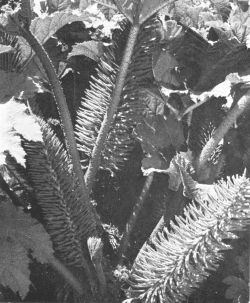
|
Gunnera
tinctoria and Gunnera manicata From Journal of the Royal New Zealand Institute of Horticulture, Vol. 1, No. 2, 1969, pp. 56-59. There are two large species of Gunnera cultivated in New Zealand and Gunnera tinctoria (syn. G. chilensis or G. scabra) is seemingly the commonest. The accompanying photograph from the garden of Mr L. H. Boisen of New Plymouth (Fig. 1) shows a particularly large plant. The total height was 8ft and the dimensions of the large leaf on the right were 5ft 6in long x 7ft wide. The petioles of G. tinctoria are covered with short prickles which are often red. In New Zealand at least the main leaf veins are also usually reddish. The large compound inflorescence seen below has a main axis several feet high from which arise lateral or side branches bearing a huge number of tiny flowers. The flowers are hermaphrodite or unisexual to varying degrees and each has a rudimentary perianth consisting of minute sepals and with or without petals. There are one or two stamens, two styles and the inferior ovary has one ovule. Both leaves and inflorescences grow up from a thick rhizome which is covered with fibrous scales.
The other large species is Gunnera manicata (syn. G. brasiliensis) (Fig. 2). This south Brazilian species can grow even taller than its Chilean relation but it looks very similar and is often mistaken for it. Again the great leaves and compound inflorescence arise from a rhizome, which is usually said to grow much longer than that in G. tinctoria. This is often not easy to judge and an easier distinguishing character, when the two species can be readily compared, is the thicker and more massive rhizome of G. manicata. The leaves of the latter are broader in proportion and have a flatter surface to the blade than those in the other species. Although the Royal Horticultural Society's Dictionary of Gardening and Bailey's Manual of Cultivated Plants state that the leaves of the Brazilian species are peltate, i.e. the petiole does not join the blade at the margin, I have never seen a plant in New Zealand with this character. A better distinguishing character can be found in the large laciniate or jaggedly cut scales at the base of the leaves and inflorescence. In G. manicata there is a prominent development of membranous "webbing" between the main lobes of the scale whereas in G. tinctoria this is not well developed and so the lobes are often almost free to the main rachis of the scale.
However, the best characters for distinguishing the two species are the different lengths and thicknesses of the inflorescence branches. As a result of these differences, the inflorescence of G. manicata appears to be more open than that in the Chilean species (Figs. 3 and 4). Branches from plants of the two species growing side by side in the Christchurch Botanic Gardens were measured in November when the actual flowering period was nearly over. At this stage, the old flowers of G. manicata were green whereas those of G. tinctoria were reddish‑brown. The following figures were obtained:
In New Zealand it seems that G. tinctoria is often confused with G. manicata. As already stated, the Chilean species seems to be commoner than the other. Both are usually grown in moist places near lakes or streams and I have not noticed much variation in either of them. Thus it is possible that only one introduction of each was made into New Zealand. In colder parts such as the eastern and southern areas of the South Island plants of both species are deciduous and lose their leaves with the first sharp frosts. During the winter, the large brown scaly resting buds are the conspicuous feature. In the warmer parts of the North Island the species are incompletely or not deciduous. These two large species of Gunnera contrast greatly with the diminutive prostrate rosette and creeping plants, sometimes with leaves less than 1in long, which also belong to the genus. The majority of the other South American species as well as all the 10 native New Zealand ones are like this. In addition there is one small species of Gunnera in Tasmania, one or two in southern Africa and Madagascar, several in the mountains of Hawaii and a larger one in Malaysia and the Philippines. All our native species have a creeping or stoloniferous habit and the most attractive features are the erect fruiting spikes. Probably the best in this respect is G. prorepens which has spikes of succulent little red drupes, but others have paler fruits and G. albocarpa even has white ones. It is interesting that even G. tinctoria and G. manicata have individual drupes which are not appreciably larger than those of our native species although the complete fruiting spikes of the latter are so diminutive in comparison. I am grateful to Mr L. H. Boisen of Seaview Road, New Plymouth for sending specimens and a photograph of his plant; to Mr Geo. Dean, Director of Parks and Reserves, Auckland City Council, to Mr L. J. Metcalf, Curator of the Christchurch Botanic Gardens, for permission to take specimens, and to Mr J. S. Cocks of the D.S.I.R., Christchurch, for taking the rest of the photographs.
|
Home | Journal
| Newsletter | Conferences
Awards | Join
RNZIH | RNZIH Directory | Links
© 2000–2024 Royal New Zealand Institute of Horticulture
Last updated: March 1, 2021




